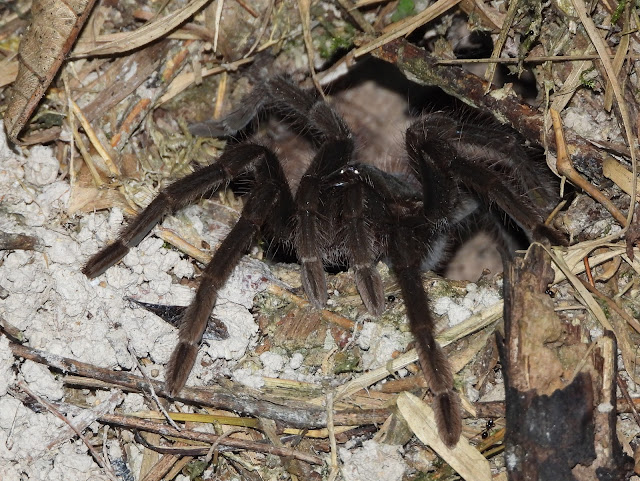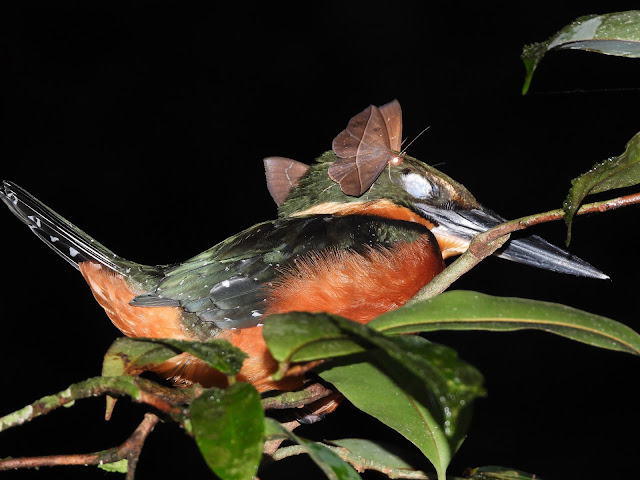Spending time in the Amazon rain-forest was the fulfillment of a dream I have had since childhood. I travelled with my family from Bogota to Leticia, crossed the border into the Brazilian Amazon port town of Tabatinga, and from there took a five-hour trip by motorboat on the Amazon river and its tributary the Javari River to The Palmari Reserve jungle lodge and research facility. The lodge sits on the Brazilian side of the Javari River overlooking Peru on the opposite bank. It was the dry and low water season so there were many exposed sandy beaches on the sides of the river.
 |
| The View from Palmari Lodge across the Javari River |
Palmari was recommended by a colleague who had stayed there doing research some years ago, as a place to see ´the real Amazon jungle´. Far enough from large settlements to still be relatively unspoilt and where there would be great opportunities for spotting lots of wildlife. It did not disappoint.
The river here is also home to a large population of two species of river dolphin, one pink and one gray in colour. We saw them many times during our stay. The dolphins are difficult to photograph as they only surface for a short time, however I did get this couple of record shots.
%20Javari%20River%20Brazil%20Peru%20Border.JPG) |
| Inia geoffrensis (Pink Amazon River Dolphin) |
%20Javari%20river%20Amazonia%20Brazil%20Peru%20Border.JPG) |
| Sotalia fluviatilis (Gray Dolphin) |
The majority of my time was spent walking the many trails through the forest around the lodge with our designated guide Augusto. He was an incredibly enthusiastic and positive guide who helped plan successful walks to see many of my target species. In the evenings Augusto took me on night walks and we also spent two evenings caiman hunting on the river. The caiman hunting was successful, both times we came across juvenile spectacled caiman and I was able to get these photos of these magnificent animals.
%20Javari%20Valley%20Amazonia%20Brasil.JPG) |
| Caiman crocodilus (spectacled caiman) Javari Valley Amazon Brazil |
%20Javari%20Valley%20Amazonia%20Brasil%20(3).JPG) |
| Caiman crocodilus (spectacled caiman) Javari Valley Amazon Brazil |
%20Javari%20Valley%20Amazonia%20Brasil%20(5)%20-%20Copy.JPG) |
| Caiman crocodilus (spectacled caiman) Javari Valley Amazon Brazil |
The night walks were also a great success and we saw lots of incredible wildlife. These two opossum species were a particular highlight for me. These mouse opossums are about as cute as it gets.
%20Javari%20Valley%20Amazonia%20Brazil.JPG) |
| Marmosa demerarae (Long-furred Woolly Mouse opossum) Javari Valley Amazon Brazil |
%20Javari%20Valley%20Amazonia%20Brazil%20(2).JPG) |
| Marmosa demerarae (Long-furred Woolly Mouse opossum) Javari Valley Amazon Brazil |
%20Javari%20Valley%20Amazonia%20Brazil%20(4).JPG) |
| Marmosa demerarae (Long-furred Woolly Mouse opossum) Javari Valley Amazon Brazil |
This common opossum was a regular visitor to the trees near the lodge kitchen.
%20Javari%20Valley%20Amazonia%20Brazil.JPG) |
| Didelphis marsupialis (Common Opossum) Javari Valley Amazon Brazil |
%20Javari%20Valley%20Amazonia%20Brazil%20(3).JPG) |
| Didelphis marsupialis (Common Opossum) Javari Valley Amazon Brazil |
I was keen to find the giant tarantulas that the Amazon is famous for, so Augusto took us to a river bank where he knew there were tarantula holes. Here I got my first sighting
Javari%20Valley%20Amazonia%20Brasil.JPG) |
| Pamphobeteus sps (Chicken Eating Spider)Javari Valley Amazonia Brasil |
My wife found another tarantula hole during the day, which I retuned to twice to get these shots. The first time, mum was off hunting and this baby spiderling was left in the hole.
juvenille%20Javari%20Valley%20Amazonia%20Brasil.JPG) |
| Pamphobeteus sps (Chicken Eating Spider)Javari Valley Amazonia Brasil |
The second time we returned at night and we enticed the tarantula out by using a thin stick to mimic the movement of prey outside the hole. This was by far the biggest tarantula that I have ever seen, the size of a dinner plate. For scale the hole in the picture is about 10+cm across.
Javari%20Valley%20Amazonia%20Brasil%20(2).JPG) |
| Pamphobeteus sps (Chicken Eating Spider)Javari Valley Amazonia Brasil |
There were plenty of lizards to be found both in the grounds of the lodge and in the surrounding jungle. Here are a selection of my favourites:
This massive green iguana was resting on a tree outside of my room.
 |
| Iguana iguana Javari Valley Amazonia Brazil |
The ameiva was common around the lodge hunting insects.
.JPG) |
| Ameiva ameiva Javari Valley Amazonia Brazil |
.JPG) |
| Ameiva ameiva Javari Valley Amazonia Brazil |
This tree runner would hide on the opposite side of the trunk when disturbed.
%20Javari%20Valley%20Amazonia%20Brasil%20(3).JPG) |
| Plica plica (Collared treerunner) Javari Valley Amazonia Brazil |
I saw several Anoles sleeping on leaves at night but only a couple on tree trunks in the day time.
%20Javari%20Valley%20Amazonia%20Brasil.JPG) |
| Anolis fuscoauratus (Brown-eared Anole) Javari Valley Amazon Brazil |
%20Javari%20Valley%20Amazonia%20Brasil.JPG) |
| Anolis trachyderma (Common Forrest Anole) Javari Valley Amazon Brazil |
I was surprised not to find any snakes other than this dead water snake.
 |
| Hydrodynastes bicinctus (Herrmanns Wter Snake) Javari Valley Amazon Brasil |
There were also plenty of frogs and toads about at night, particularly near the small streams in the jungle, some small and others huge.
%20Javari%20Valley%20Amazonia%20Brazil.JPG) |
| Scinax ruber (Tree Frog) Javari Valley Amazonia Brazil |
%20Javari%20Valley%20Amazonas%20Brazil.JPG) |
| Ameerega hahneli (Yurimaguas poison frog) Javari Valley Amazon Brazil |
%20Javari%20Valley%20Amazonia%20Brazil.JPG) |
| Boana lanciformis (Rocket Tree Frog) Javari Valley Amazon Brazil |
%20Javari%20Valley%20Amazonia%20Brazil.JPG) |
| Leptodactylus pentadactylus (Amazon Smokey Jungle Frog) Javari Valley Amazon Brazil |
 |
| Rhinella ornata Javari Valley Amazon Brazil |
%20Javari%20Valley%20Amazonia%20Brazil.JPG) |
| Rhinella margaritifera (Leaf Litter Toad) Javari Valley Amazon Brazil |
 |
| Rhinella proboscidea Javari Valley Amazon Brasil |
Laura and Tuki, Palmari's friendly tame rescued birds.
 |
| Laura the Blue and Yellow Macaw |
 |
| Tuki the Yellow-ridged toucan |
We had a great week at Palmari and I will take away many good memories from my time there in the Amazon.
 |
| The Giant Sacred Saber Tree |
%20Amazon%20nr%20Leticia%20Colombia%20(3).JPG)
%20Amazon%20nr%20Leticia%20Colombia%20(2).JPG)
%20Amazon%20nr%20Leticia%20Colombia%20(4).JPG)



%20Amazon%20Nr%20Leticia%20Colombia.JPG)
%20Amazon%20Nr%20Leticia%20Colombia.JPG)


%20Amazon%20Nr%20Leticia%20Colombia%20(3).JPG)
.JPG)

.JPG)

%20%20Amazon%20Nr%20Leticia%20Colombia.JPG)
%20Amazon%20Nr%20Leticia%20Colombia.JPG)
%20Amazon%20nr%20Leticia%20Colombia.JPG)
%20Amazon%20Nr%20Leticia%20Colombia.JPG)


%20Amazon%20nr%20Leticia%20Colombia%20(4).JPG)



%20Javari%20River%20Brazil%20Peru%20Border.JPG)
%20Javari%20river%20Amazonia%20Brazil%20Peru%20Border.JPG)
%20Javari%20Valley%20Amazonia%20Brasil.JPG)
%20Javari%20Valley%20Amazonia%20Brasil%20(3).JPG)
%20Javari%20Valley%20Amazonia%20Brasil%20(5)%20-%20Copy.JPG)
%20Javari%20Valley%20Amazonia%20Brazil.JPG)
%20Javari%20Valley%20Amazonia%20Brazil%20(2).JPG)
%20Javari%20Valley%20Amazonia%20Brazil%20(4).JPG)
%20Javari%20Valley%20Amazonia%20Brazil.JPG)
%20Javari%20Valley%20Amazonia%20Brazil%20(3).JPG)
Javari%20Valley%20Amazonia%20Brasil.JPG)
juvenille%20Javari%20Valley%20Amazonia%20Brasil.JPG)
Javari%20Valley%20Amazonia%20Brasil%20(2).JPG)

.JPG)
.JPG)
%20Javari%20Valley%20Amazonia%20Brasil%20(3).JPG)
%20Javari%20Valley%20Amazonia%20Brasil.JPG)
%20Javari%20Valley%20Amazonia%20Brasil.JPG)

%20Javari%20Valley%20Amazonia%20Brazil.JPG)
%20Javari%20Valley%20Amazonas%20Brazil.JPG)
%20Javari%20Valley%20Amazonia%20Brazil.JPG)
%20Javari%20Valley%20Amazonia%20Brazil.JPG)

%20Javari%20Valley%20Amazonia%20Brazil.JPG)

%20Javari%20Valley%20Amazonia%20Brazil%20(3).JPG)
%20Javari%20Valley%20Amazonia%20Brazil.JPG)
%20Javari%20Valley%20Amazonia%20Brazil%20(2).JPG)
%20Javari%20Valley%20Amazonia%20Brazil%20(3).JPG)
%20Javari%20Valley%20Amazonia%20Brazil.JPG)
%20Javari%20Valley%20Amazonia%20Brazil%20(4).JPG)
%20Javari%20Valley%20Amazonia%20Brazil%20(2).JPG)
%20Javari%20Valley%20Amazonas%20Brazil.JPG)
%20Javari%20Valley%20Amazonas%20Brazil%20(4).JPG)
%20Dad%20specimen%20Javari%20Valley%20amazonas%20Brazil.JPG)
%20Javari%20Valley%20Amazonas%20Brazil.JPG)
%20Javari%20Valley%20Amazonas%20Brazil%20(2).JPG)
%20Javari%20Valley%20Amazonas%20Brazil.JPG)
%20Javari%20Valley%20Amazonas%20Brazil.JPG)

%20Javari%20Valley%20Amazonas%20Brazil.JPG)

.JPG)
%20Javari%20Valley%20Amazonas%20Brazil.JPG)
%20Javari%20Valley%20Amazonas%20Brazil.JPG)
%20Javari%20valley%20Amazonas%20Brazil.JPG)
%20Javari%20Valley%20Amazonas%20Brazil.JPG)




